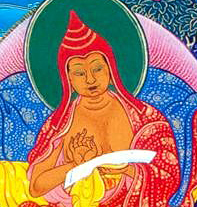Haribhadra
Jump to navigation
Jump to search
Haribhadra (T. seng ge bzang po སེང་གེ་བཟང་པོ་) (late 8th C.) was an Indian Buddhist scholar whose commentaries on the prajnaparamita sutras are widely studied in the Tibetan Buddhist tradition.
Haribhadra's writings include:
- Abhisamayālaṃkārālokā (Light on the Ornament) - a commentary that correlates the verses of the Abhisamayālaṃkāra with corresponding sections in the Aṣṭadaśasāhasrikāprajñāpāramitā
- Abhisamayālaṃkāravivṛti (a.k.a. Sphuṭārthā) - a summary of the Abhisamayālaṃkārālokā
- Pañcaviṃśatisāhasrikāprajñāpāramitā (The [Recast] Perfection of Wisdom in Twenty-Five Thousand Lines; a.k.a. Eight Chapters on the 25,000) - a commentary on the Pañcaviṃśatisāhasrikā Prajñāpāramitā Sūtra
- Bhagavadratnaguṇasaṃcayagāthāpañjikānāma - a commentary on the Verse Summary of the Perfection of Wisdom
The Princeton Dictionary states:
- His Abhisamayālaṃkārālokā builds upon Pramāṇa, Madhyamaka, and Abhidharma literature and was extremely influential in Tibet; its summary (known as "’grel pa don gsal" in Tibetan) is the root text (rtsa ba) for commentaries in the Gsang phu ne’u thog monastery tradition originating with Rngog Blo ldan shes rab. It is the most widely studied prajñāpāramitā commentary in Tibetan Buddhism to the present day.[1]
Taranatha says he was a disciple of Shantarakshita. He was a teacher of Buddhajñānapāda.
Notes
- ↑ Robert E. Buswell Jr., Donald S. Lopez Jr., The Princeton Dictionary of Buddhism (Princeton: 2014), s.v. Haribhadra
Further Reading
 Haribhadra, Tsadra Commons
Haribhadra, Tsadra Commons Haribhadra, Rigpa Shedra Wiki
Haribhadra, Rigpa Shedra Wiki- David Seyfort Ruegg, The Literature of the Madhyamaka School of Philosophy in India, Wiesbaden: Harrassowitz, 1981, pp. 101-103
- Lobsang N. Tsonawa, Indian Buddhist Pandits from The Jewel Garland of Buddhist History, Dharamsala: Library of Tibetan Works and Archives, 1985.
